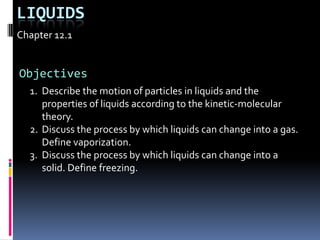Chapter 12.1 : Liquids
•Descargar como PPTX, PDF•
2 recomendaciones•1,031 vistas
Denunciar
Compartir
Denunciar
Compartir

Recomendados
Más contenido relacionado
La actualidad más candente
La actualidad más candente (20)
Destacado
Destacado (20)
Introduction to Science 3.1 : Exploring Physical Science

Introduction to Science 3.1 : Exploring Physical Science
Similar a Chapter 12.1 : Liquids
Similar a Chapter 12.1 : Liquids (20)
Chapter 1 kinetic particle theory notes ( class test )

Chapter 1 kinetic particle theory notes ( class test )
Más de Chris Foltz
Más de Chris Foltz (20)
Earth Science 3.3 : Absolute Dating: A Measure of Time

Earth Science 3.3 : Absolute Dating: A Measure of Time
Earth Science 3.1 : Earth's Story and Those Who First Listened.

Earth Science 3.1 : Earth's Story and Those Who First Listened.
Earth Science 3.2 : Relative Dating : Which Came First?

Earth Science 3.2 : Relative Dating : Which Came First?
Último
Explore beautiful and ugly buildings. Mathematics helps us create beautiful d...

Explore beautiful and ugly buildings. Mathematics helps us create beautiful d...christianmathematics
Último (20)
Kisan Call Centre - To harness potential of ICT in Agriculture by answer farm...

Kisan Call Centre - To harness potential of ICT in Agriculture by answer farm...
BAG TECHNIQUE Bag technique-a tool making use of public health bag through wh...

BAG TECHNIQUE Bag technique-a tool making use of public health bag through wh...
Beyond the EU: DORA and NIS 2 Directive's Global Impact

Beyond the EU: DORA and NIS 2 Directive's Global Impact
Explore beautiful and ugly buildings. Mathematics helps us create beautiful d...

Explore beautiful and ugly buildings. Mathematics helps us create beautiful d...
Web & Social Media Analytics Previous Year Question Paper.pdf

Web & Social Media Analytics Previous Year Question Paper.pdf
Z Score,T Score, Percential Rank and Box Plot Graph

Z Score,T Score, Percential Rank and Box Plot Graph
Disha NEET Physics Guide for classes 11 and 12.pdf

Disha NEET Physics Guide for classes 11 and 12.pdf
IGNOU MSCCFT and PGDCFT Exam Question Pattern: MCFT003 Counselling and Family...

IGNOU MSCCFT and PGDCFT Exam Question Pattern: MCFT003 Counselling and Family...
A Critique of the Proposed National Education Policy Reform

A Critique of the Proposed National Education Policy Reform
Chapter 12.1 : Liquids
- 1. Liquids Chapter 12.1 Objectives Describe the motion of particles in liquids and the properties of liquids according to the kinetic-molecular theory. Discuss the process by which liquids can change into a gas. Define vaporization. Discuss the process by which liquids can change into a solid. Define freezing.
- 2. Liquids Examples: Oceans, lakes, rivers Hard to believe – liquids are the least common state in the universe Why? Narrow temperature range they can exist in!
- 3. Properties of Liquids and Kinetic-Molecular Theory Definite volume, take shape of container According to Kinetic-Molecular Theory Liquid’s particles are: In constant random motion Closer together than gases, there are attractive forces More ordered than gases, so particles are held together, but do have mobility. Fluid: substance that can flow and therefore take the shape of its container
- 4. Relatively High Density Thousands of times denser than gases Slightly less dense than solids Due to the close arrangement of liquid particles
- 6. Constant, random motion of particles
- 8. Evaporation and Boiling Vaporization: Process by which a liquid or solid changes to a gas Evaporation: Process by which particles escape from the surface of a non-boiling liquid and enter the gas state. Boiling: Change in liquid to bubbles of vapor that appear throughout the liquid.
- 9. Formation of Solids When liquid is cooled, average kinetic energy decreases Particles slow down Attractive forces pull into an orderly arrangement Freezing (solidification): Physical change of a liquid to a solid by removal of heat.